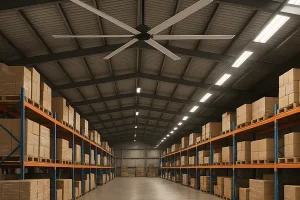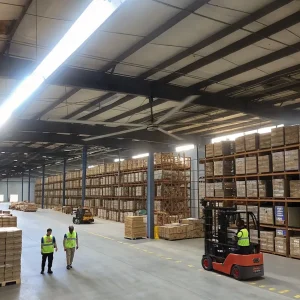Factories and warehouses often grapple with stale air, high temperatures, and rising energy bills. This challenge stifles productivity, raises tension among staff, and increases operational costs. However, one promising cooling solution exists: installing large industrial fans that can drastically improve air circulation and comfort while lowering electricity usage.
Large industrial fans are commonly called HVLS fan—short for High Volume Low Speed. These fans are essential in industrial and commercial facilities like a warehouse because they move large volumes of air at a low speed, optimizing airflow. They are sometimes known by brand names like big ass fans®,and Vindus fans,designed to reduce heat, promote ventilation, and create a more comfortable work environment. By installing these wide-diameter fans overhead, businesses gain a cost-effective way to keep employees cool and processes running smoothly.

hvls fan Settings
When businesses talk about large industrial fans, they often use the term HVLS fan. HVLS stands for High Volume Low Speed. This definition captures how these fans function: they produce a high volume of air while rotating at a low speed. Unlike smaller residential fans, they typically measure seven feet in diameter or more. Some can reach spans of 24 feet, giving them the power to move ample air around.
An industrial fan references a robust, heavy duty mechanical device engineered for demanding settings. They’re used in manufacturing plants, distribution centers, or sports complexes to maintain comfort and efficiency. These fans are distinct from the smaller ceiling fan found at home because they operate in more intense conditions—sometimes handling dust and debris, moisture and humidity, and high temperatures.
Because these fans revolve at low speed, they can displace large volumes of air gently, rather than using abrupt high-speed blasts. This gentler approach fosters better airflow in large open spaces like a barn, gym, or warehouse. They also often serve as a more cost-effective method of climate control in large or tall buildings.
A key difference rests in design, purpose, and output. While residential fans or standard fans function in small rooms or homes, an industrial ceiling fan is built to withstand the rigors of commercial-scale demands. Industrial fans come in many forms, but the fan is the most common industrial fixture typically installed on overhead beams, especially for facilities that need to move large volumes of air.
Manufactured with large diameter blades—often surpassing seven feet in diameter—industrial fans are specifically made to handle bigger tasks. Their fan blades can be wide and specially contoured for maximum performance. This design ensures that each rotation can shift more air, impacting temperature, ventilation, and comfort for larger footprints.
Unlike smaller pedestal fan designs, industrial fans revolve at slower speeds but cover broader zones. They also often handle higher static pressure, meaning they can push air across obstacles or large distances. Because they are bigger and heavier, they require strong overhead support, typically a reliable industrial ceiling to hold them safely in place.
Industrial fans are engineered to move large volumes of air in multiple ways. Two common categories are the axial fan and the centrifugal fan. These types of fans differ in blade orientation and function, each contributing to air movement in specific industrial contexts.
An axial fan is the most straightforward design: it propels air parallel to the fan’s axis. Axial blades are pitched in such a way that rotating them pushes air forward, similar to a ceiling fan. Axial fans are typically used in applications where higher volume of air flow at lower pressure is desired, making them perfect for ventilation in a warehouse or factory.
A centrifugal fan—sometimes known as a blower—has a different airflow pattern. It draws air in axially and expels it radially. Backward curved fans are a popular variant because they offer high efficiency for moving air against higher pressure. They often appear in duct systems, process lines, or dust-collection setups. Another key difference is that centrifugal fans typically handle high pressure scenarios well.
HVLS fans can be a game-changer for ventilation in a warehouse. Their large coverage area means a single warehouse fan can move air from corner to corner, reducing hot spots and pockets of stagnant, humid air. Since a hvls fan operates at a low speed, it gently pulls hot air down from the industrial ceiling and mixes it with cooler air below.
HVLS fans do more than just stir up a breeze. They help maintain consistent temperatures from floor to ceiling, which is critical for product quality, worker comfort, and energy savings. By redistributing hot air at the top and cooler air at the bottom, fans help reduce the need for heavy reliance on HVAC systems—potentially saving thousands in annual costs.
For a busy warehouse, routine activities can generate dust and debris, vapor, or automotive fumes if vehicles are operating indoors. HVLS fans provide an effective solution by sweeping these contaminants away, improving air quality. They also discourage moisture buildup, crucial for preventing mold or corrosion on stored goods. By cycling the air around with large, broad strokes, HVLS fans keep warehouses fresh and well-ventilated.

How Do HVLS Fans Help Ventilation in a Warehouse
Size often matters when it comes to fans used in industrial settings. Large industrial fans with a large diameter can move air more thoroughly. That’s because bigger blades displace more volume per rotation, letting them push air across bigger distances.
When looking at “cooling fans,” we often picture smaller units, but industrial cooling fans aim to serve entire manufacturing floors or distribution hubs. The fan moves air in a more sweeping pattern, ensuring every worker or occupant feels the breeze. Because a hvls fan can be used in areas like a barn, aviation hangar, or massive supermarket, it can effectively meet cooling demands over thousands of square feet.
High volume of air doesn’t have to mean intense wind gusts that disrupt processes. Instead, the low speed approach ensures a gentle airflow that boosts occupant comfort without scattering inventory or creating hazardous wind tunnels. So these “fans help” by creating an environment that’s breezy yet stable enough for delicate tasks.
Industrial fans are engineered with robust materials and advanced blade geometry. Often called “high volume low speed” fans, they revolve slower than typical, achieving steady, broad coverage. The result is a superior method to move large volumes of air in large spaces such as manufacturing shops, open spaces, or stadiums.
Because these fans operate in demanding conditions, they’re built to withstand extreme usage. The frames, brackets, and motor housings use metal alloys or heavy steels. Fans are built for consistent rotation over thousands of hours without faltering, ensuring minimal maintenance downtime.
By ensuring better air circulation, industrial fans help maintain stable climate conditions that reduce the load on air conditioning or heating systems. This synergy can cut overhead significantly and is precisely why industrial fans help to keep monthly bills manageable. The net effect is a more comfortable work environment that fosters better employee morale and productivity.
Industrial fans come in many forms, each suited to specific tasks or building designs. Typically, you’ll see references to:
The difference is not only about size but also performance. While residential fans mainly serve to keep smaller rooms comfy, industrial fans are typically installed overhead, often with large fan blades measuring multiple feet across. They deal with bigger volumes of air, more continuous usage, and heavier demands.
Fans are typically more rigid and use more powerful motors in industrial settings. They must also handle demanding conditions like dusty environments, variable temperatures, or heavy forklift traffic. That’s why, from an engineering standpoint, fans are designed with more robust features compared to simpler home units.

Fan Application In Large Commercial Buildings
Yes. By generating consistent airflow and air circulation throughout a building, industrial cooling fans can drastically improve air quality. When air remains static, moisture accumulates, encouraging mold or mildew in corners. Over time, excessive moisture can degrade products or equipment and foster an unhealthy atmosphere for workers.
In many industrial and commercial processes, vapor or fumes can build up. Large fans like axial or centrifugal variants keep air moving, dispersing any vapor that might otherwise linger. Additionally, many industries need to control humidity levels to maintain product integrity—industrial fans become a big asset in ensuring dryness.
Dust, debris, or automotive particulates (in warehouses where trucks drive in) can degrade air quality if left stagnant. By running large overhead fans, you encourage these particles to remain airborne for a moment, allowing filtration or ventilation systems to capture them more effectively. This synergy means less dust settling on equipment or stock, thus better longevity and cleanliness.
Backward curved fans exemplify advanced engineering in industrial fan design. Their curved blades permit a more efficient airflow path, lowering energy consumption at a given output. Such fans meet the demands of high efficiency because they handle the air within ducts or systems with minimal drag.
Unlike smaller or more traditional fans, industrial-grade solutions can handle high pressure or large airflow volumes. Because many facilities have extensive duct networks or partial obstructions, a specialized fan approach ensures consistent performance. Hence, the selection of a certain fan—like backward curved or forward curved—can drastically influence system outcomes.
At our hvls fans Manufacturing plants for products, we see how customers across automotive, agriculture, or warehousing industries each require unique fan solutions. Some rely on the power of a blower to force air through ducts, while others prefer HVLS designs for wide, open areas. By matching the fan design to your building’s profile, you ensure proper ventilation that suits your specific day-to-day processes.
Owners and managers in factories, warehouses, or commercial buildings often face challenges from poor airflow and rising energy costs. This can harm air quality, lower productivity, and spike utility bills. Large industrial fans, especially HVLS units and brands like big ass fans®, stand out as fans play an integral role in solving these issues.
At our HVLS fans Manufacturing enterprise, we see daily how these fans can help regulate climate in industrial spaces. Whether you need a warehouse fan or want to keep a barn free from stale air, installing large speed industrial solutions can drastically improve your environment. Our fan solutions come in many configurations—axial fan, centrifugal fan, or HVLS—that can handle moisture and humidity and protect your workforce.
Picture achieving proper ventilation in a warehouse with minimal fuss and reduced reliance on AC. Imagine walking into a production line that’s comfortable all day, free from swirling dust or hotspots. By choosing an HVLS fan or high-capacity industrial cooling fans, you can enjoy better occupant health, stable temperatures, and a safer environment for employees. Thanks to engineered to move large volumes design, these fans ensure broad coverage with a single or minimal number of installations.
Ready to transform your facility’s air within? Speak with us about selecting an ideal fan for your space. Our team at HVLS fans Manufacturing can tailor solutions—like industrial ceiling fan systems, axial fan sets, or a centrifugal fan arrangement—to meet the unique constraints of your building. We help you harness the power of high volume airflow while keeping low speed operation. Contact us to explore how an HVLS approach can drastically cut operating costs and enhance your daily operations.
| Fan Type | Key Features | Best For |
|---|---|---|
| Axial Fan | Simple design, parallel air flow; handles high volume at lower pressure. | Ventilation in big spaces |
| Centrifugal Fan | Air drawn in axially, expelled radially; can handle high pressure conditions. | Duct systems, dust collection |
| HVLS Fan | Large diameter, low speed, can move large volumes of air. | Open spaces like a warehouse |
| Pedestal Fan | Portable, localized cooling. | Spot cooling in industrial lines |
This chart shows how each type addresses distinct facility needs. For example, a centrifugal fan might handle material-laden air, while an HVLS fan is prime for open-floor distribution. By identifying your building’s environment, you can pick the perfect fit.
An automotive parts manufacturer had trouble keeping employees cool on the assembly line. Conventional traditional fans or small-scale blowers proved insufficient for the large open spaces. After installing a single HVLS system with fan blades spanning over seven feet in diameter, the plant saw a 25% drop in the cost of running AC. Worker comfort soared, absenteeism dropped, and management appreciated the effective solution for year-round air circulation.
“We were skeptical at first about how one big fan can move enough air,” notes the site manager, “but we quickly realized this fan can move an enormous volume of air at low speed, creating a steady breeze that kept everyone happy. It was an ideal fan for our environment.”
Are large industrial fans only used to cool automotive facilities?
No. While they’re extremely popular in automotive production lines, these industrial fans help many industries, including agriculture, warehousing, and retail. Fans are used widely to manage heat, ventilate spaces, and ensure staff comfort.
How large can these fans get?
A large ceiling or overhead unit can have a large diameter up to 24 feet, pushing thousands of cubic feet per minute of air. In fact, some HVLS models can measure beyond seven feet in diameter for maximum coverage in large industrial fans applications.
Which fan is the most common in an industrial setting?
The fan is the most common fixture is often a high-volume, low-speed overhead industrial ceiling fan, especially in sprawling or tall buildings. Alternatively, axial or centrifugal designs are prevalent in specialized processes requiring blower capacity.
Do industrial fans also help with dust and debris?
Yes, fans include the ability to keep air moving, preventing particles from accumulating on surfaces. By improve airflow, they encourage filtration systems to capture floating dust more efficiently and reduce debris buildup on machinery.
Can these fans be used to cool or ventilate a barn?
Absolutely. Many industrial fans help maintain dryness, comfort, and fresh conditions in a barn. Livestock or produce can benefit from consistent air movement, discouraging stagnant pockets or damp conditions.
In short, if you manage commercial fans or industrial facilities—be it a warehouse, gym, or automotive plant—upgrading to large HVLS fan solutions is a smart step. Not only do you improve day-to-day comfort and air within your building, but you also unlock energy savings by relying less on conventional AC or multiple small fans. Contact our HVLS fans Manufacturing team to explore how we can optimize airflow and enhance your bottom line with advanced, heavy duty solutions that deliver true air movement value.

Hi, I’m Michael Danielsson, CEO of Vindus Fans, with over 15 years of experience in the engineering and design industry. I’m here to share what I’ve learned. If you have any questions, feel free to contact me at any time. Let’s grow together!